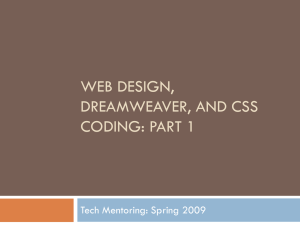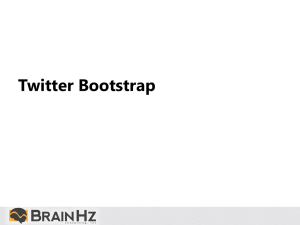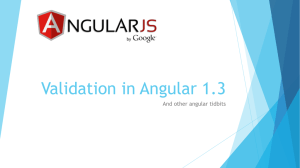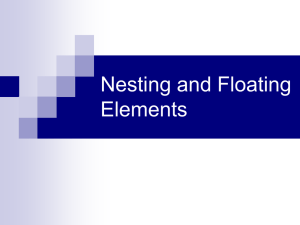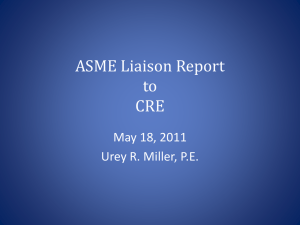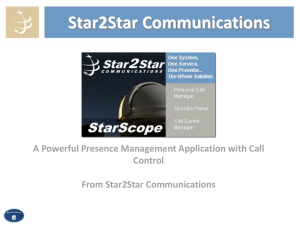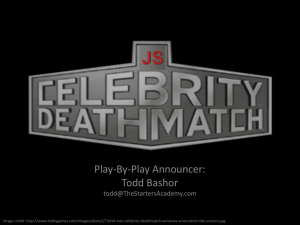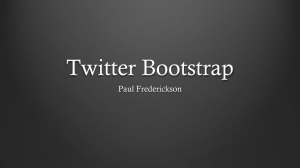4.02WebLayout
advertisement
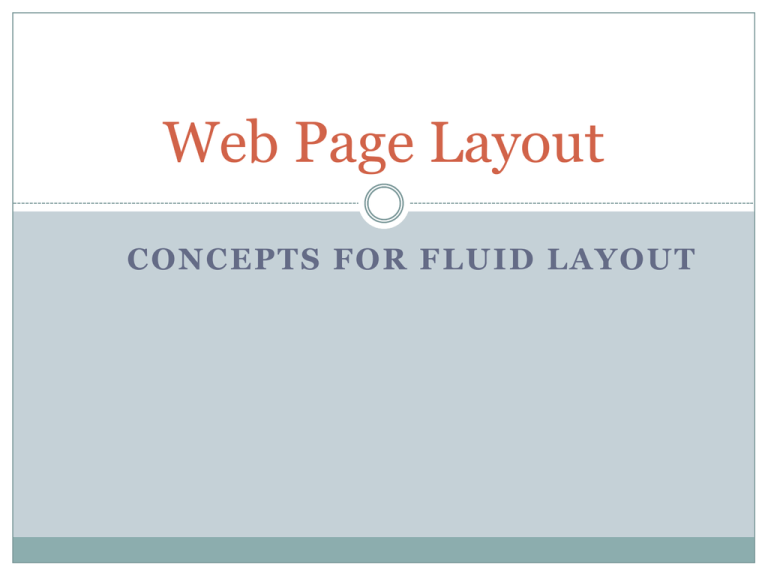
Web Page Layout CONCEPTS FOR FLUID LAYOUT Website Layouts Most websites have organized their content in multiple columns (formatted like a magazine or newspaper). Multiple columns are created by using <div> or <table> elements. Cascading Style Sheets are used to position elements, or to create backgrounds or a colorful look for the pages. Even though it is possible to create nice layouts with HTML tables, tables were designed for presenting tabular data - NOT as a layout tool! Example Layouts Layouts that work on many devices <div> layouts and CSS can create flexible layouts that work on various screen sizes. Responsive web design is a web design approach aimed at crafting sites to provide an optimal viewing experience—easy reading and navigation with a minimum of resizing, panning, and scrolling—across a wide range of devices. Responsive Web Design Layout changes to fit the device Common resolutions on various devices Devices vary in resolution and pixel density As hardware changes, resolution and pixel density change Web layout needs to be flexible and adjust to various mobile devices and new devices A pixel is an abstract unit of measurement and it does not have a single specific size. More than one type of Pixel Device pixel Reference pixel CSS pixel Bitmap pixel The smallest Reference CSS pixel is a The smallest unit of physical unit pixels are based unit of measure data in a raster in a display on an optical image. reference unit and developed by the w3c A Popular Page Layout using <div> <div> defined The <div> tag defines a division or a section in an HTML document. The <div> tag is used to group block-elements to format them with CSS. The <div> element is very often used together with CSS, to layout a web page How many <div> elements in this code? Container div header div content div Footer div 7 div elements The Power of <div> Web developers use <div> elements to group together HTML elements and apply CSS styles to many elements at once. <div> tag and attributes The <div> tag supports the global attributes in HTML HTML 5 has introduced some new global attributes Global attributes can be used on any HTML element Some examples of global attributes id - Specifies a unique id for an element class - Specifies one or more classnames for an element (refers to a class in a style sheet) style - Specifies an inline CSS style for an element lang - Specifies the language of the element's content These are just a few examples. It is not the complete list. <header> <footer> <nav> are new in html5 A fairly standard layout consists of a banner near the top, navigation, and your content or display box. These are the backbone to any great website. In HTML5 there is a <header> element, as well as a <nav>, <footer> that can replace these div tags. Semantic elements Many of existing web sites today contains HTML code like this: <div id="nav">, <div class="header">, or <div id="footer">, to indicate navigation links, header, and footer. HTML5 offers new semantic elements to clearly define different parts of a web page; such as <header> Container elements The <header> tag specifies a header for a document or section. The <header> element should be used as a container for introductory content or set of navigational links. The <footer> tag defines a footer for a document or section. A footer typically contains the author of the document, copyright information, links to terms of use, contact information, etc. The <nav> tag defines a set of navigation links. It is only intended for a major block of navigation links. CSS for div #main-wrap refers to the div id. The id attribute specifies a unique name Why use Fixed Layout A fixed website layout has a wrapper that is a fixed width, and the components inside it have either percentage widths or fixed widths. The important thing is that the container (wrapper) element is set to not move. No matter what screen resolution the visitor has, he or she will see the same width as other visitors. Fixed Layout in Pixels In this example 960 pixels is the fixed width. 40 px left and right margins 20 px space Fixed Layout in Pixels • The container div is 40 px left and right margins Header div Sidebar div Content div 20 px space Footer div 960px • The header div is 880px plus 80 pixels of margins. • The Content div and sidebar div plus a 20px space equal 880 px From Fixed to Fluid • Compute 40 px left and right margins Percentages and change from pixels to percents Header 92% Content div Sidebar div 25% 73% 20 px space Footer div From Fixed Layout to Fluid The concept of fixed layout to fluid means we want to calculate an equivalent percentage to use inside the wrapper div. In our example, we divide 880 ÷ 960 = 0.91666667 Which we will round to 92 The content and sidebar areas are within the 880-pixelwide wrapper div, we need to find the percentages of these relative to this div so: 640 pixels ÷ 880 pixels = 0.727272 → 73% 220 pixels ÷ 880 pixels = 0.25 → 25% Why consider Fluid Layout In a fluid website layout, also referred to as a liquid layout, the majority of the components have percentage widths, and thus adjust to the user’s screen resolution. Fixed-Width Layout 520 + 20 + 200 + 20 + 200 = 960 pixels Fluid Layout 200px/960px=20% 520/960=54% 20px/960px=2% Relative Units Relative layouts are accomplished by using a relative unit like the em or the percent ("%"). The em is basically the height of the font being used on the page. It is considered relative because a 16 point font has a different height from, say, a 12 point font. The percent has the normal meaning you are used to from mathematics. That is, if the width of the page is set to 80%, it means 80% of the maximum width it can have. It's regarded as relative since the maximum width varies depending on how big your browser window is. The term “em” is a reference to the Letter “M” in written form. What is an em unit? “Ems” (em): The “em” is a scalable unit that is used in web document media. An em is equal to the current fontsize, for instance, if the font-size of the document is 12pt, 1em is equal to 12pt. Ems are scalable in nature, so 2em would equal 24pt, .5em would equal 6pt, etc. Ems are becoming increasingly popular in web documents due to scalability and their mobile-device-friendly nature. Factors to consider in Layout Screen resolution and pixel density Browser choice Whether or not the browser is maximized Extra toolbars open in the browser (History, Bookmarks, etc.) The operating system and hardware Resources http://coding.smashingmagazine.com/2009/06/02/fixed- vs-fluid-vs-elastic-layout-whats-the-right-one-for-you/ http://www.w3schools.com/ http://kyleschaeffer.com/development/css-font-size-emvs-px-vs-pt-vs/

